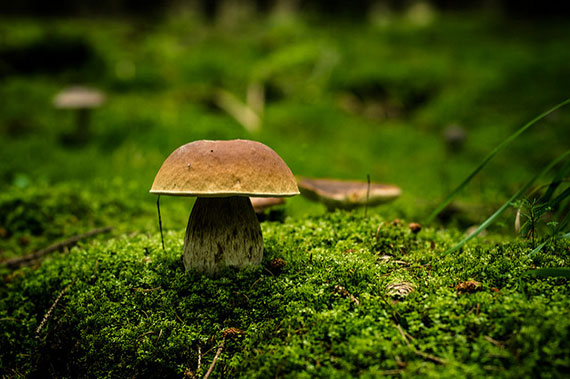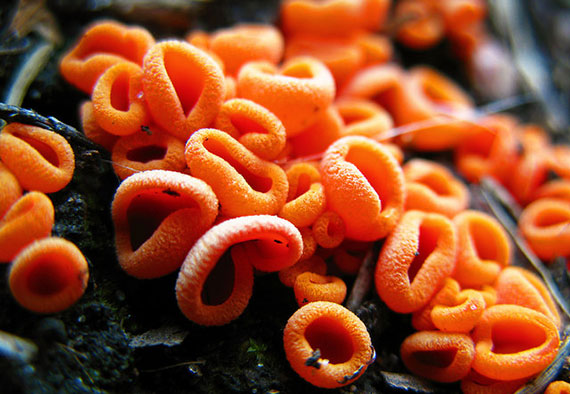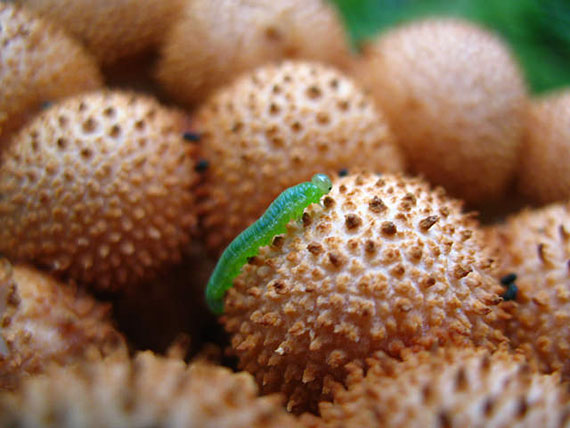Most photographers shy away from shooting fungi, mostly because it is not seen as a glamorous thing to do. Yet these life forms are just begging to be photographed, and the picture potential is there to be taken. Fungi can be found anywhere where organic matter is decaying, especially in woodland, and in particular around autumn and early winter.

Photo by Oliver Henze; ISO 320, f/1.0, 1/140-second exposure.
To photograph fungi all you need is a simple set-up, so this form of photography is widely accessible and thoroughly enjoyable.
Where To Find Fungi
Different types of fungi need their own habitats, but most will be found growing in deciduous woodland. The best places to look for them are on fallen branches and decaying stumps. You can also find them among mossy areas and dense leaf litter. Another good place to find them is on tree trunks, when a telephoto lens will be required.
One thing to remember about fungi is that they spread as mycelia (very thin root-like structures) underground and absorb nutrients from decaying vegetation before revealing their existence on the surface as reproductive fruiting bodies we commonly see as toadstools or mushrooms. These mycelia can travel for a at least a mile underground.
Your Photography Gear
Most lenses can be used to shoot fungi, but because some species may be quite small, a dedicated macro lens will be the preferred lens to use. Macro lenses give results that are life-size. They also give you maximum aperture, which means you will get a brighter image that is essential in dark woodland.
If you do not have a macro lens you can easily use much cheaper, but effective, close-up filters. These do not affect your camera’s automatic functions. Another possibility is the use of extension tubes.
An effective way of photographing fungi is to use a telephoto or a zoom lens from a distance to isolate the fungi from their surroundings. Actually, different focal lengths will help create different perspectives and results, so it is best to experiment.

Photo by Andrei Zverev; f/3.2, 1/60-second exposure.
A tripod, especially one that the legs can be splayed almost flat will be very useful when shooting fungi. If shooting at ground level, a bean bag will be most handy. Be sure to lay out a plastic groundsheet to kneel on in order to keep your legs dry.
In order to minimize camera shake, even though you are using a steadying tripod, it is best to take the shot with a remote release rather than pressing the shutter. Alternatively, use your camera’s self-timer.
Beware of toxins. Although some mushrooms are edible, it is generally a good idea not to handle fungi unless you know the subject well. There are some types of fungi out there that are known to be poisonous and potentially deadly. So if you find that you need to clean bits of vegetation and dirt off a fruiting body, say, it will be safer to use a blower brush instead of picking off the particles with your fingers.
Getting In Close
As soon as you have found a good-looking fungus to photograph, be it the fruiting body of a puffball mushroom, a stinkhorn mushroom, a death cap mushroom or whatever, you need to figure out the best way to photograph it.
The good thing about photographing fungi is that they are static objects, so you have lots of time to shoot them. Look at the surrounding light and the size and shape of the fruiting body.
If the amount of light is an issue, that will mean mounting your camera on a tripod or beanbag. Then, the actual exposure time won’t matter much. However, fungi—being what they are—tend to grow in uneven and awkward places, so setting up your tripod can become a bit fiddly. Patience in setting up will always be rewarded.
The Lighting
Woodlands being dark places by nature means that fungi generally prefer to grow in dark spots. Fungi are not plants, so they have no need for light in order to flourish. The dark environment in which you find the fruiting bodies means that the available light has to be supplemented.
A typical fruiting body like a mushroom has more light on the cap than on the underparts, so if you don’t balance the light a lot of detail will be missing in the photograph. You can rectify this by using a reflector or fill flash.
A reflector can be hand-held or placed nearby the fungus so that lateral light falls on the subject at an angle. By moving the reflector closer or farther away, you can vary the light intensity. You don’t have to use a fancy foil umbrella like you use in studio photography. Instead, you can use a white card or a piece of aluminum foil to act as the reflector.
Fill-flash is used to lighten the shadows. Normally it is best to reduce the output of the flash by a couple of stops to balance the flash with the ambient surrounding light. You will have to experiment on the subject distance.
Off-camera flash is generally the preferred method to use because of its versatility and the way it gives fungi a more natural look. You simply place the flash to the side or at an angle to create interesting backlighting, which will be particularly impressive on translucent fruiting bodies.

Photo by Andrei Zverev; ISO 161, f/2.8, 1/60-second exposure.
Image Sharpness
If your camera has mirror lock-up, use it. This will maximize image sharpness in the poor lighting conditions associated with fungi photography. Mirror lock-up works by locking-up the reflex mirror in a DSLR camera before firing the shutter. This reduces unwanted vibrations. It will work best when the camera is fitted to a tripod and when the self-timer or a remote release is also used.
Beware of Toxins
As mentioned, never handle unknown species of fungus because they may be potentially poisonous or even deadly.
About the Author:
Chris Smith is a photography expert and writer for an online magazine.
Like This Article?
Don't Miss The Next One!
Join over 100,000 photographers of all experience levels who receive our free photography tips and articles to stay current:






Thanks for the article! I’d like to comment that no mushroom is toxic or poisonous to touch. Touch them all you want without fear! Consuming them is where you should be more concerned.
My Fungi pic :D
https://www.flickr.com/photos/71492873@N02/13096619445/
I find fungi so lovely! Your pictures are simply awesome.
Recently I published my humble two cents on fungi and mushrooms: http://anagss.blogspot.com/2011/05/setas-mushrooms-funghi.html